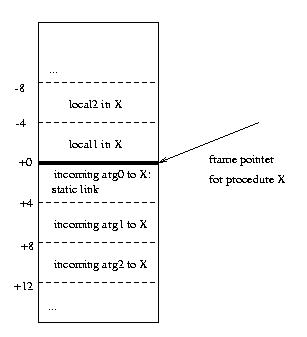
datatype bop = Plus | Min | Mul | Div
datatype exp =
Num of int
| Bin of exp * bop * exp
| Dec of string * exp * exp
| Var of string
| Function of string * exp
| Call of exp * exp
| NewArray of exp * exp
| ArrayIndex of exp * exp
| ArrayAssign of exp * exp * exp
All parameters should be passed by value. Like Java, there are two
kinds of values: primitive values like integers and reference values
which point to "objects" in the heap. There are two kinds of
heap-allocated objects: functions and arrays.
Here are some examples:
(*
f = fn (x) array(x,0) // take an x and
// create an array of size x initialized to zeroes
a1 = f(10) // a1 is an array of size 10 initialized to zeroes
a2 = f(20) // a1 is an array of size 20 initialized to zeroes
x = (a2[5] = 1000) // update array a2 at index 5 with value 1000; x = 1000
y = a1[5]
return y // should return 0
*)
val e1 = Dec("f", Function("x", NewArray(Var("x"), Num(0))),
Dec("a1", Call(Var("f"), Num(10)),
Dec("a2", Call(Var("f"), Num(20)),
Dec("x", ArrayAssign(Var("a2"), Num(5), Num(1000)),
Dec("y", ArrayIndex(Var("a1"), Num(5)),
Var("y"))))))
(*
f = fn (x) (fn (y) x+y)
f(10)(20) // should return 30
*)
val e2 = Dec("f", Function("x", Function("y", Bin(Var("x"), Plus, Var("y")))),
Call(Call(Var("f"),Num(10)),Num(20)))
(*
f = fn (g) {
x = 1
g(x)
}
x = 3
f (fn(y) x+y) // should return 4
*)
val e3 = Dec("f", Function("g", Dec("x",Num(1),Call(Var("g"),Var("x")))),
Dec("x", Num(3),
Call(Var("f"), Function("y",Bin(Var("x"),Plus,Var("y"))))))
program Main
let var flag := 1
var x1 := 1
function P (y1:int) : int =
let var x2 := 2
function Q (y2:int) : int =
let var x3 := 3
function R (y3:int) : int =
if flag
then (flag := 0; P(x1) + y2)
else y2
in y1 + R(x3)
end
in x1 + Q(y1) end
in P(9) end
end
At run time, the program performs the following sequence of calls:
Main, P, Q, R, P, Q, R .
Assuming that the general shape of an activation record is as in
the following figure:

R
. Your figure should include all activation records on the
stack, the values (and names for clarity) of each variable on the
stack, and the location each static link points to.
y3 , y2 and
flag . A typical expression would look like:
*(*(*(FP+4)+4)-8) where FP is the frame pointer
and *p fetches the contents of pointer p
as in the C language.
sabry@cs.uoregon.edu